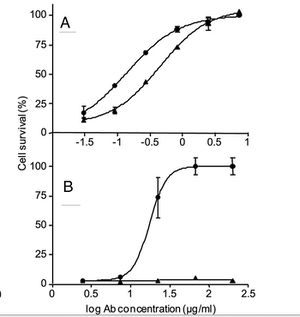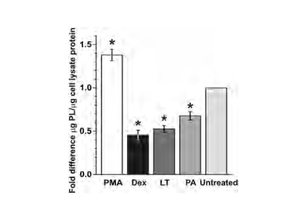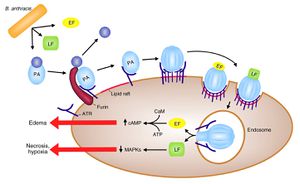Bacillus Anthracis: Anthrax Lethal Toxin: Difference between revisions
No edit summary |
No edit summary |
||
| Line 23: | Line 23: | ||
[[Image:cAb29Fig.jpg|thumb|300px|center|Figure 1. A and B show the neutralization assay performed using cultured J774A macrophages that were incubated for 5 h with fixed amounts of LF and PA83 (A) or purified prepore (B) in the presence of cAb29 (circles) or Ab33 (triangles) in the indicated concentrations. Cell survival was determined by XTT and plotted as the percentage of untreated control cells. Points are mean ± S.D. of triplicate determinants. Ab concentration, antibody concentration (Mechaly).]] | [[Image:cAb29Fig.jpg|thumb|300px|center|Figure 1. A and B show the neutralization assay performed using cultured J774A macrophages that were incubated for 5 h with fixed amounts of LF and PA83 (A) or purified prepore (B) in the presence of cAb29 (circles) or Ab33 (triangles) in the indicated concentrations. Cell survival was determined by XTT and plotted as the percentage of untreated control cells. Points are mean ± S.D. of triplicate determinants. Ab concentration, antibody concentration (Mechaly).]] | ||
[[Image:surfactantFig.png|thumb|300px|center|LT decreases surfactant production in AEC. Early-culture AEC were treated with LT (2�g/ml) for 72 h and harvested. Phorbol 12-myristate (PMA; 50 ng/ml) and dexamethasone (Dex; | [[Image:surfactantFig.png|thumb|300px|center|LT decreases surfactant production in AEC. Early-culture AEC were treated with LT (2�g/ml) for 72 h and harvested. Phorbol 12-myristate (PMA; 50 ng/ml) and dexamethasone (Dex; 1µM) were used as positive and negative controls, respectively. Surfactant levels in supernatants were measured by a phospholipid assay and normalized to protein content per sample. Data are means SEM of the results from 3 experiments on 3 separate individuals, with 2 to 4 trials for each treatment. *, P value of �0.05 versus untreated cells (Langer).]] | ||
[[Image:BAnthracisPathogenesis.jpg|thumb|300px|center|The process of <i>B. anthracis</i> pathogenesis begins with the binding of PA to a host cell. The PA molecule is then cleaved and oligomerizes, at which time it can bind LF and EF forming LeTx and EdTx. These complexes are then internalized into the cell, where LeTx causes reduced intracellular MAPK concentration, resulting in necrosis and hypoxia, and EdTx causes increased intracellular cAMP concentration, resulting in edema around the infection site.]] | [[Image:BAnthracisPathogenesis.jpg|thumb|300px|center|The process of <i>B. anthracis</i> pathogenesis begins with the binding of PA to a host cell. The PA molecule is then cleaved and oligomerizes, at which time it can bind LF and EF forming LeTx and EdTx. These complexes are then internalized into the cell, where LeTx causes reduced intracellular MAPK concentration, resulting in necrosis and hypoxia, and EdTx causes increased intracellular cAMP concentration, resulting in edema around the infection site.]] | ||
Revision as of 02:27, 25 April 2013
Introduction
By Connor Gibbons
At right is a sample image insertion. It works for any image uploaded anywhere to MicrobeWiki. The insertion code consists of:
Double brackets: [[
Filename: PHIL_1181_lores.jpg
Thumbnail status: |thumb|
Pixel size: |300px|
Placement on page: |right|
Legend/credit: Electron micrograph of the Ebola Zaire virus. This was the first photo ever taken of the virus, on 10/13/1976. By Dr. F.A. Murphy, now at U.C. Davis, then at the CDC.
Closed double brackets: ]]
Other examples:
Bold
Italic
Subscript: H2O
Superscript: Fe3+
Anthrax is a disease that typically affects herbivores but can infect any mammal, including humans. It is caused by the bacterium Bacillus anthracis (B. anthracis). This disease has become a hot topic in today’s society, in which terrorism is becoming more prevalent, as it can be used in biological warfare. Recently, there has also been an increase in the number of cases of injection anthrax, a form of the disease that affects heroin users, in Europe (Grunow). However, this disease is not new. In fact, there is evidence of it throughout history. The fifth and sixth plagues in Egypt (Exodus, Chapter 9) have been attributed to this pathogen (Baillie).
The species derives its name from the Greek word anthrakis, meaning coal, because infection by the organism causes the formation of black, cutaneous eschars (Spencer). There are are three types of B. anthracis infection that are typically described: cutaneous anthrax (the cause of the black sores), inhalation anthrax (the most deadly form), and gastrointestinal anthrax (Mock, Mignot).



Introduce the topic of your paper. What microorganisms are of interest? Habitat? Applications for medicine and/or environment?
Organism
Include some current research, with at least one figure showing data.
Life Cycle
Include some current research, with at least one figure showing data.
Pathogenesis
Include some current research, with at least one figure showing data.
Clinical Symptoms and Diagnosis
Overall text length at least 3,000 words, with at least 3 figures.
Anthrax Toxin Neutralization with Antibody
During infection by B. anthracis, protective antigen is integral in the intoxication of the host cells by anthrax toxins. This protein, therefore, is a logical target for scientists seeking to neutralize the anthrax toxins. Mechaly, et al. have recently found that the antibody cAb29, does just that: it targets PA molecules, interfering with the function of the molecule and thereby neutralizing the anthrax toxin (Mechaly).

The Mechaly group, in attempting to determine the mechanism by which cAb29 functions to neutralize the toxins, found that cAb29 does not have any effect on the initial steps of the intoxication process: PA molecules are still able to bind to the target cell via receptors on the target cell membrane. These molecules are still cleaved by the furin-family protease and they still oligomerize into hepatomers which bind EF and LF molecules. Instead, they discovered that the antibody binds to the prepore, which is the complex of PA and either LF or EF before it is internalized by the cell, preventing the acid catalyzed transition to the transmembranal pore (Mechaly).
Their tests showed 100% survival of mice injected intravenously with cAb29 12 hours after initial exposure to B. anthracis (Figure 1). This is a very important discovery as it could possibly lead to a cure for the disease even if it is not caught in the very early stages of infection (Mechaly).

Target Cells in Humans in Inhalation Anthrax
References
Edited by student of Joan Slonczewski for BIOL 238 Microbiology, 2011, Kenyon College.

